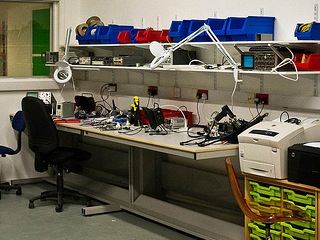Difference between revisions of "Equipment/Electronics Workbenches"
From Makespace
(→Equipment: List current equipment in more detail) |
|||
| Line 15: | Line 15: | ||
</gallery> | </gallery> | ||
| − | + | === Components and small tools === | |
| + | |||
* PCB holders or "helping hands" | * PCB holders or "helping hands" | ||
* Magnifying lamps | * Magnifying lamps | ||
* Side cutters | * Side cutters | ||
* Multimeters | * Multimeters | ||
| − | |||
| − | |||
* Wire | * Wire | ||
* Selection of basic components (res, caps, v-reg, basic digital logic, basic IC's - 555,358, connectors, cable) | * Selection of basic components (res, caps, v-reg, basic digital logic, basic IC's - 555,358, connectors, cable) | ||
| + | |||
| + | === Electronic and soldering equipment === | ||
| + | |||
| + | * Soldering irons: | ||
| + | ** 2x Tenma AT60D soldering stations (up to 400C) | ||
| + | |||
| + | * Rework station: | ||
| + | ** (Need more information here) | ||
| + | |||
| + | * Bench power supplies (e.g. a mix of 5V, 12V, variable, and multi-rail PSUs) | ||
| + | ** Farnell AP20-80: up to 20V at up to 80A | ||
| + | ** Hameg HM7042-3 dual: each channel up to 32V at up to 2A | ||
| + | ** Tenma 72-8695 two channels each up to 32V at up to 3A, plus a single fixed 5V/2A channel | ||
| + | |||
| + | * Oscilloscopes: | ||
| + | ** Hameg HM-203s 20MHz analogue | ||
| + | ** Philips PM 3217 50MHz analogue | ||
| + | |||
| + | * Signal generators: | ||
| + | ** Thurlby Thandar TG212 0.1Hz-2MHz function generator (sine, square, sawtooth) | ||
| + | ** Black*Star Jupiter 500 0.1Hz-500kHz function generator (sine, square, sawtooth) | ||
| + | |||
| + | * Universal counter: | ||
| + | ** Thurlby Thandar TF830 1.3GHz high resolution reciprocal measurement | ||
| + | |||
| + | * Timer/counter: | ||
| + | ** Philips PM6622 80MHz | ||
| + | |||
| + | * Logic analyser: | ||
| + | ** HP 16500A (status unknown: may not be operational but has probes pack) | ||
| + | |||
| + | === Notes === | ||
| + | |||
| + | It would be nice if someone could dig out URLs for manuals for the above, if available, and link to them from their listing lines. | ||
== Requirements Notes == | == Requirements Notes == | ||
Revision as of 14:28, 5 November 2013
Equipment / Electronics Workbenches
Workbenches for electronics and precision work.
Contents
Benches
- 2x 1800mm x 900mm ESD cantilever benches http://www.bigdug.co.uk/workshop-benches-c348/antistatic-workbenches-c721/antistatic-workbenches-capacity-300kgs-pp4582
Equipment
Components and small tools
- PCB holders or "helping hands"
- Magnifying lamps
- Side cutters
- Multimeters
- Wire
- Selection of basic components (res, caps, v-reg, basic digital logic, basic IC's - 555,358, connectors, cable)
Electronic and soldering equipment
- Soldering irons:
- 2x Tenma AT60D soldering stations (up to 400C)
- Rework station:
- (Need more information here)
- Bench power supplies (e.g. a mix of 5V, 12V, variable, and multi-rail PSUs)
- Farnell AP20-80: up to 20V at up to 80A
- Hameg HM7042-3 dual: each channel up to 32V at up to 2A
- Tenma 72-8695 two channels each up to 32V at up to 3A, plus a single fixed 5V/2A channel
- Oscilloscopes:
- Hameg HM-203s 20MHz analogue
- Philips PM 3217 50MHz analogue
- Signal generators:
- Thurlby Thandar TG212 0.1Hz-2MHz function generator (sine, square, sawtooth)
- Black*Star Jupiter 500 0.1Hz-500kHz function generator (sine, square, sawtooth)
- Universal counter:
- Thurlby Thandar TF830 1.3GHz high resolution reciprocal measurement
- Timer/counter:
- Philips PM6622 80MHz
- Logic analyser:
- HP 16500A (status unknown: may not be operational but has probes pack)
Notes
It would be nice if someone could dig out URLs for manuals for the above, if available, and link to them from their listing lines.
Requirements Notes
Wishlist
- Abrasive pen
- Heatsink tweezers
- Logic Analyser
- spectrum analyser
- ESD handling equipment, eg. anti-static mats, wrist-strap, earth points, tester
- USB microscope with monitor?
Bench Requirements (based on conversations with lots of people!)
- Height: Standard workstation/stool height (~840mm) rather than desk/chair height - allows working standing or sitting on stools
- Depth: Standard electronics workstation depth of ~900mm to allow for equipment at the back whilst still giving decent workspace
- ESD - whilst some people don't care, other seem to care a lot, so assume antistatic worksurface
- Structure - A long workbench surface along the wall of the main workshop, approximately 4m; Options:
- Standard electronics workbenches (metal structure bench with drawers below left/right, back power strip at back, raised shelf)
- Basic electronics workbences without storage below, cantilever or 4-post design
- Worksurface (e.g. kitchen) fixed to wall with some drawer units as stands (e.g. ikea)
- Other considerations:
- Allow for a variable number of people to sit at it (i.e. bucnh up, couple of people around same project)
- Decent storage for all the basic tools, components
- Some form of raised area for scopes/test equipment
- Very sturdy - i.e. wont move if lent on, pushed against etc

